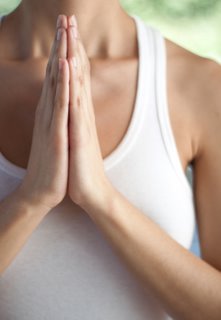
prayer is good medicine
Two researchers find merit to the idea that spiritual influences can have a beneficial, physiologically measurable impact.
By Larry Sokoloff
Inspired by a visit to a hospital in India run by Sri Sathya Sai Baba and his followers, two Duke University researchers are investigating the effects prayer and other nonmedical practices can have on a patient’s recovery after angioplasty.
Cardiologist Mitchell W. Krucoff and nurse practitioner Suzanne Crater were amazed by the upbeat reaction of patients and staff at the Institute for Higher Medical Sciences in Putta Parthi following the daily visits of Sai Baba, whose followers worship him as an avatar, an incarnation of divinity.
In contrast to the lethargy and depression common in many hospitals, the euphoric atmosphere at the Institute was overwhelming, Krucoff says. Patients and staff were beaming throughout the researchers’ visit. “God came every day and made rounds and touched them,” Krucoff says. “That kind of atmosphere has got to have physiological impact.”
After their visit, the two researchers wanted to test the idea that spiritual influences could have a physiologically measurable impact. But how do you measure the religious influence that they had witnessed? As Krucoff says, “We couldn’t scatter Sai Baba clones or Mother Teresa clones all over the United States.”
Instead, Krucoff and Crater wondered what would happen if prayer and other forms of nonmedical treatment were offered to patients undergoing stressful heart procedures. Would patients who were prayed for or taught to relax benefit more than patients who were not? Their musings led them to begin the MANTRA study (Monitor and Actualization of Noetic TRAinings) at the Durham, North Carolina, Veterans Affairs Medical Center. Besides a group of patients who had prayers said for them, three other groups were exposed to touch, guided visualization, or stress relaxation. A fifth group served as a control group and did not receive any prayers or treatments.
The most unusual part of the study—and apparently the most effective—involved the healing use of prayer. The study found that angioplasty patients with acute coronary syndromes who were prayed for did 50 to 100 percent better (in terms of heart rate, blood pressure, and EKG results) than did patients in the control group. Patients who received guided imagery, touch, or stress relaxation assistance also benefited, showing a 30 to 50 percent trend toward improved outcomes.
Prayers were offered by seven different religious groups. Each group received the same data: the name of a male patient who was undergoing a catheter procedure, a stressful operation which involves threading a tube into the heart while the patient is awake. The prayers went out from Buddhist monasteries in Nepal and France, from Moravians in North Carolina, and from Carmelite nuns in Baltimore who prayed during evening vespers. In Jerusalem, prayers were inserted in the city’s Western Wall by a Jewish group. Fundamentalist Christians, Baptists, and Unitarians prayed as well.
The prayers proved effective even though the MANTRA patients didn’t know they were being prayed for, unlike the beaming patients in India who saw Sri Baba at their bedsides.
A larger trial of 1,500 patients is now under way at hospitals in North Carolina, San Diego, Washington, D.C., and Oklahoma City. The larger study will test whether the results can be repeated, and may influence doctors in the future to include spirituality in their prescriptions.

Prayer timers and clocks with chimes
Now & Zen, Inc.
1638 Pearl St.
Boulder, CO 80302
(800) 779-6383
adapted from Yoga Journal.com
Posted in yoga, Yoga Timers by Now & Zen